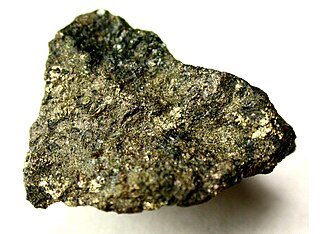
Pentlandite is an iron–nickel sulfide with the chemical formula (Fe,Ni)9S8. Pentlandite has a narrow variation range in nickel to iron ratios (Ni:Fe), but it is usually described as 1:1. In some cases, this ratio is skewed by the presence of pyrrhotite inclusions. It also contains minor cobalt, usually at low levels as a fraction of weight.

Petalite, also known as castorite, is a lithium aluminum phyllosilicate mineral LiAlSi4O10, crystallizing in the monoclinic system. Petalite occurs as colorless, pink, grey, yellow, yellow grey, to white tabular crystals and columnar masses. It occurs in lithium-bearing pegmatites with spodumene, lepidolite, and tourmaline. Petalite is an important ore of lithium, and is converted to spodumene and quartz by heating to ~500 °C and under 3 kbar of pressure in the presence of a dense hydrous alkali borosilicate fluid with a minor carbonate component. Petalite (and secondary spodumene formed from it) is lower in iron than primary spodumene, making it a more useful source of lithium in, e.g., the production of glass. The colorless varieties are often used as gemstones.

Hemimorphite is the chemical compound Zn4(Si2O7)(OH)2·H2O, a component of mineral calamine. It is a silicate mineral which, together with smithsonite (ZnCO3), has been historically mined from the upper parts of zinc and lead ores. Both compounds were originally believed to be the same mineral and classified as calamine. In the second half of the 18th century, it was discovered that these two different compounds were both present in calamine. They closely resemble one another.
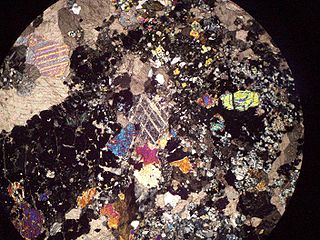
Skarns or tactites are coarse-grained metamorphic rocks that form by replacement of carbonate-bearing rocks during regional or contact metamorphism and metasomatism. Skarns may form by metamorphic recrystallization of impure carbonate protoliths, bimetasomatic reaction of different lithologies, and infiltration metasomatism by magmatic-hydrothermal fluids. Skarns tend to be rich in calcium-magnesium-iron-manganese-aluminium silicate minerals, which are also referred to as calc-silicate minerals. These minerals form as a result of alteration which occurs when hydrothermal fluids interact with a protolith of either igneous or sedimentary origin. In many cases, skarns are associated with the intrusion of a granitic pluton found in and around faults or shear zones that commonly intrude into a carbonate layer composed of either dolomite or limestone. Skarns can form by regional or contact metamorphism and therefore form in relatively high temperature environments. The hydrothermal fluids associated with the metasomatic processes can originate from a variety of sources; magmatic, metamorphic, meteoric, marine, or even a mix of these. The resulting skarn may consist of a variety of different minerals which are highly dependent on both the original composition of the hydrothermal fluid and the original composition of the protolith.

Aurichalcite is a carbonate mineral, usually found as a secondary mineral in copper and zinc deposits. Its chemical formula is (Zn,Cu)5(CO3)2(OH)6. The zinc to copper ratio is about 5:4. Copper (Cu2+) gives aurichalcite its green-blue colors.

Moolooite is a rare blue-green mineral with the formula Cu(C2O4)·n(H2O) (n<1) (copper(II) oxalate hydrate). It was discovered in Bunbury Well, Mooloo Downs station, Murchison, Western Australia in 1986. It has an orthorhombic crystalline structure, and is formed by the interaction of bird guano with weathering copper sulfides.

Abswurmbachite is a copper manganese silicate mineral ((Cu,Mn2+)Mn3+6O8SiO4). It was first described in 1991 and named after Irmgard Abs-Wurmbach (born 1938), a German mineralogist. It crystallizes in the tetragonal system. Its Mohs scale rating is 6.5 and a specific gravity of 4.96. It has a metallic luster and its color is jet black, with light brown streaks.

Allophane is an amorphous to poorly crystalline hydrous aluminium silicate clay mineraloid. Its chemical formula is Al2O3·(SiO2)1.3-2·(2.5-3)H2O. Since it has short-range atomic order, it is a mineraloid, rather than a mineral, and can be identified by its distinctive infrared spectrum and its X-ray diffraction pattern. It was first described in 1816 in Gräfenthal, Thuringia, Germany. Allophane is a weathering or hydrothermal alteration product of volcanic glass and feldspars and sometimes has a composition similar to kaolinite but generally has a molar ratio of Al:Si = 2. It typically forms under mildly acidic to neutral pH (5–7). Its structure has been debated, but it is similar to clay minerals and is composed of curved alumina octahedral and silica tetrahedral layers. Transmission electron micrographs show that it is generally made up of aggregates of hollow spherules ~3–5 nm in diameter. Allophane can alter to form halloysite under resilicating aqueous conditions and can alter to form gibbsite under desilicating conditions. A copper-containing variety cupro-allophane has been reported.

Shattuckite is a copper silicate hydroxide mineral with formula Cu5(SiO3)4(OH)2. It crystallizes in the orthorhombic – dipyramidal crystal system and usually occurs in a granular massive form and also as fibrous acicular crystals. It is closely allied to plancheite in structure and appearance.
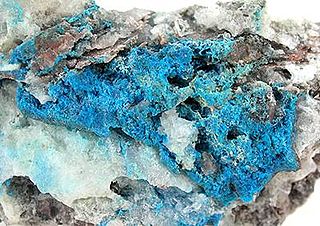
Papagoite is a rare cyclosilicate mineral. Chemically, it is a calcium copper aluminium silicate hydroxide, found as a secondary mineral on slip surfaces and in altered granodiorite veins, either in massive form or as microscopic crystals that may form spherical aggregates. Its chemical formula is Ca Cu Al Si2O6(O H)3.

Ajoite is a hydrated sodium potassium copper aluminium silicate hydroxide mineral. Ajoite has the chemical formula (Na,K)Cu7AlSi9O24(OH)6·3H2O, and minor Mn, Fe and Ca are usually also present in the structure. Ajoite is used as a minor ore of copper.

Eucryptite is a lithium bearing aluminium silicate mineral with formula LiAlSiO4. It crystallizes in the trigonal – rhombohedral crystal system. It typically occurs as granular to massive in form and may pseudomorphically replace spodumene. It has a brittle to conchoidal fracture and indistinct cleavage. It is transparent to translucent and varies from colorless to white to brown. It has a Mohs hardness of 6.5 and a specific gravity of 2.67. Optically it is uniaxial positive with refractive index values of nω = 1.570 – 1.573 and nε = 1.583 – 1.587.
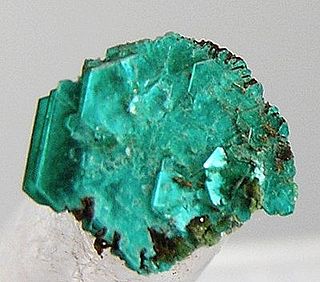
Chalcophyllite is a rare secondary copper arsenate mineral occurring in the oxidized zones of some arsenic-bearing copper deposits. It was first described from material collected in Germany. At one time chalcophyllite from Wheal Tamar in Cornwall, England, was called tamarite, but this name is now discredited. At Wheal Gorland a specimen exhibiting partial replacement of liriconite, Cu
2Al(AsO
4)(OH)
4·(4H
2O), by chalcophyllite has been found. The mineral is named from the Greek, chalco "copper" and fyllon, "leaf", in allusion to its composition and platy structure. It is a classic Cornish mineral that can be confused with tabular spangolite.

Iranite (Persian: ایرانیت) is a triclinic lead copper chromate silicate mineral with formula Pb10Cu(CrO4)6(SiO4)2(F,OH)2. It was first described from an occurrence in Iran. It is the copper analogue of hemihedrite (Pb10Zn(CrO4)6(SiO4)2(F,OH)2).

Plancheite is a hydrated copper silicate mineral with the formula Cu8Si8O22(OH)4•(H2O). It is closely related to shattuckite in structure and appearance, and the two minerals are often confused.
Apachite is a copper silicate mineral with a general formula of Cu9Si10O29·11H2O. The name is associated with the Apache tribe residents of the area near the Christmas copper mine in the Dripping Spring Mountains of Gila County, Arizona, the location where apachite was first described in 1980.

Gilalite is a copper silicate mineral with chemical composition of Cu5Si6O17·7(H2O).

Junitoite is a mineral with formula CaZn2Si2O7·H2O. It was discovered at the Christmas mine in Christmas, Arizona, and described in 1976. The mineral is named for mineral chemist Jun Ito (1926–1978).
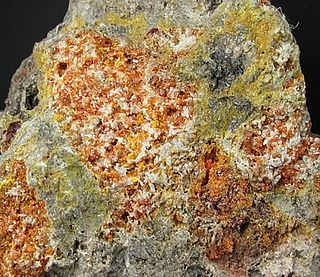
Hemihedrite is a rare lead zinc chromate silicate mineral with formula Pb10Zn(CrO4)6(SiO4)2(F,OH)2. It forms a series with the copper analogue iranite.

Scottyite is a barium copper silicate. It was named for Michael Scott, first CEO of Apple. Its type locality is the Wessels mine, Northern Cape, South Africa, where it was first identified. It has also been found at several localities in the Rhineland-Palatinate.



















